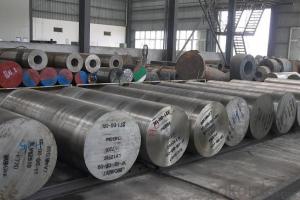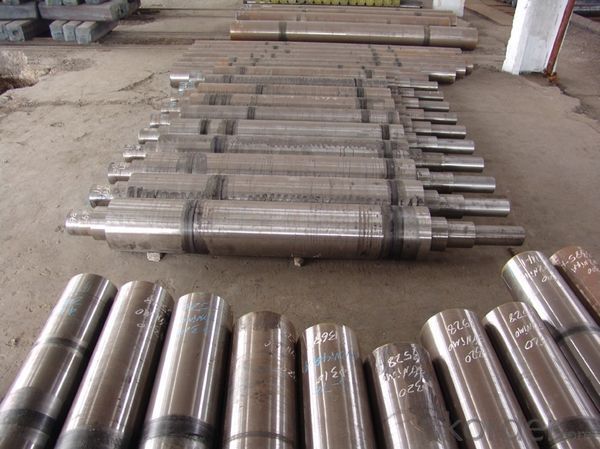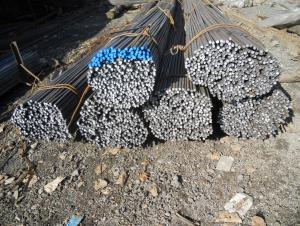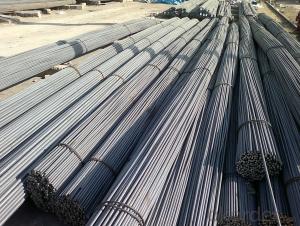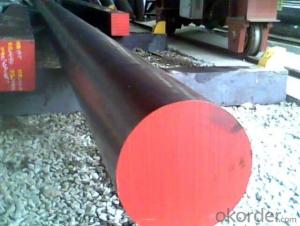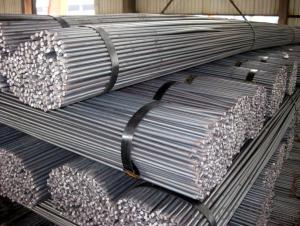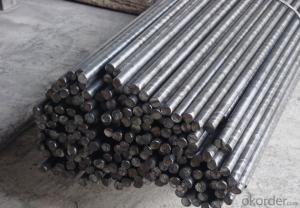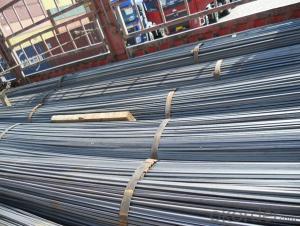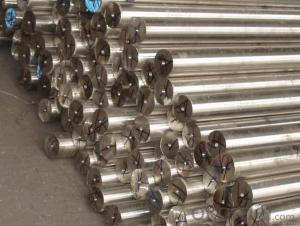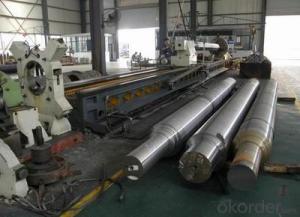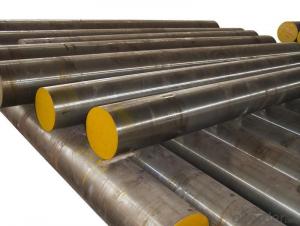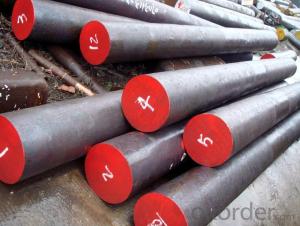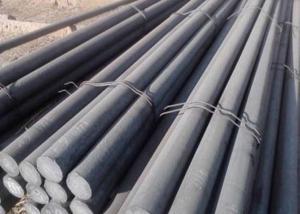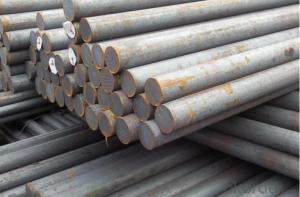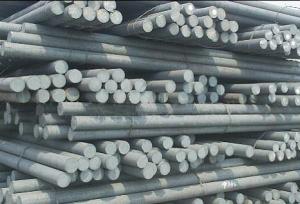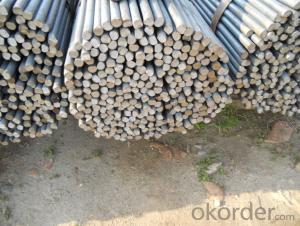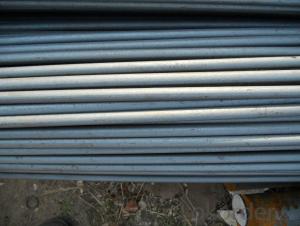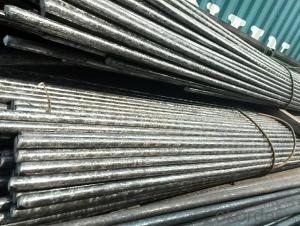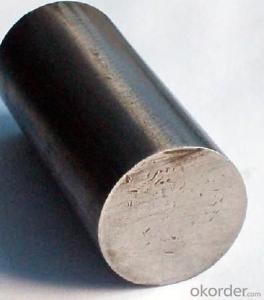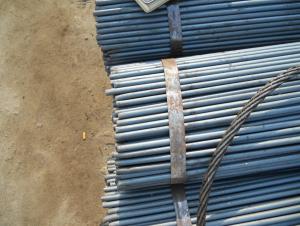35CrMo China Standard Forged Steel Round Bar
- Loading Port:
- Shanghai
- Payment Terms:
- TT or LC
- Min Order Qty:
- 25 m.t.
- Supply Capability:
- 10000 m.t./month
OKorder Service Pledge
OKorder Financial Service
You Might Also Like
Product Description:
OKorder is offering Round Bar at great prices with worldwide shipping. Our supplier is a world-class manufacturer of steel, with our products utilized the world over. OKorder annually supplies products to European, North American and Asian markets. We provide quotations within 24 hours of receiving an inquiry and guarantee competitive prices.
Product Applications:
1) Suitable for making various strong cutting tool abrasion resistance, impact resistance.
2) Used to produce all kinds of high hard and super hard saw blade, drill, tap, broach, gear hob and various kinds of milling cutter.
3) Used for advanced punching die, screw die, and the toughness and complicated shape of the punch, etc.
4) Is used for cold forging die and drawing mode, etc.
5) Recommended watchcase factory, screw factory and other cold stamping products industry use.
Product Advantages:
OKorder's Round Bar are durable, strong, and resist corrosion.
Main Product Features:
· Premium quality
· Prompt delivery & seaworthy packing (30 days after receiving deposit)
· Corrosion resistance
· Can be recycled and reused
· Mill test certification
· Professional Service
· Competitive pricing
Product Specifications:
Diameter | Mass | Diameter | Mass | Diameter | Mass |
(mm) | (kg/m) | (mm) | (kg/m) | (mm) | (kg/m) |
6 | 0.22 | 22 | 2.98 | 53 | 17.30 |
7 | 0.30 | 24 | 3.55 | 56 | 19.30 |
8 | 0.40 | 25 | 3.85 | 60 | 22.20 |
9 | 0.50 | 26 | 4.17 | 63 | 24.50 |
10 | 0.62 | 28 | 4.83 | 65 | 26.00 |
11 | 0.75 | 30 | 5.55 | 70 | 30.20 |
12 | 0.89 | 32 | 6.31 | 75 | 34.70 |
13 | 1.04 | 34 | 7.13 | 80 | 39.50 |
14 | 1.21 | 36 | 7.99 | 85 | 44.50 |
15 | 1.39 | 38 | 8.90 | 90 | 49.90 |
16 | 1.58 | 40 | 9.86 | 95 | 55.60 |
17 | 1.78 | 42 | 10.90 | 100 | 61.70 |
18 | 2.00 | 45 | 12.50 | 120 | 88.85 |
19 | 2.23 | 48 | 14.20 | 140 | 120.93 |
20 | 2.47 | 50 | 15.40 | 150 | 138.82 |
FAQ:
Q1: Why buy Materials & Equipment from OKorder.com?
A1: All products offered byOKorder.com are carefully selected from China's most reliable manufacturing enterprises. Through its ISO certifications, OKorder.com adheres to the highest standards and a commitment to supply chain safety and customer satisfaction.
Q2: How do we guarantee the quality of our products?
A2: We have established an advanced quality management system which conducts strict quality tests at every step, from raw materials to the final product. At the same time, we provide extensive follow-up service assurances as required.
Q3: What makes stainless steel stainless?
A3: Stainless steel must contain at least 10.5 % chromium. It is this element that reacts with the oxygen in the air to form a complex chrome-oxide surface layer that is invisible but strong enough to prevent further oxygen from "staining" (rusting) the surface. Higher levels of chromium and the addition of other alloying elements such as nickel and molybdenum enhance this surface layer and improve the corrosion resistance of the stainless material.
Images:
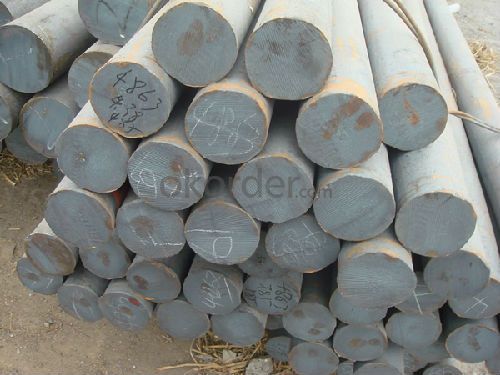
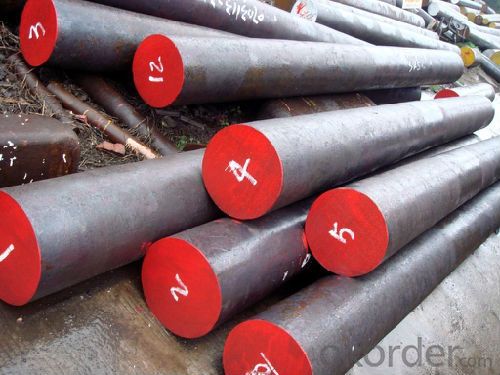
- Q: Can I use steel bar instead of steel bar?
- Important stress parts should not be adopted. Reinforced surface made of thread, herringbone bond force is increased to crescent, steel and concrete, reinforced some parts if it is ends with a ribbed design can not bend, it is possible to design directly paste up, it is best to ask the design unit.
- Q: What are the advantages of using carbon steel round bars?
- Using carbon steel round bars in various applications offers several advantages. To begin with, carbon steel round bars are renowned for their exceptional strength and durability. They possess a high tensile strength, making them ideal for heavy-duty tasks that involve carrying substantial loads and enduring intense pressures. As a result, carbon steel round bars find extensive use in the construction, manufacturing, and engineering sectors. Another benefit of carbon steel round bars lies in their remarkable machinability. They can be effortlessly cut, drilled, and shaped into diverse forms, rendering them highly versatile for different projects. This flexibility allows for precise and accurate fabrication, ensuring that the desired specifications and dimensions are achieved. Furthermore, carbon steel round bars exhibit excellent weldability, enabling easy joining using various welding techniques. This feature makes them highly preferred for constructing structures and machinery that demand strong and secure connections. Moreover, carbon steel round bars offer a cost-effective solution compared to other materials with similar properties. They strike an optimal balance between performance and affordability, making them a favored choice across many applications. Additionally, their long lifespan and minimal maintenance requirements contribute to cost savings over time. Carbon steel round bars also possess a high resistance to corrosion and wear, thanks to the presence of carbon and other alloying elements. This enhanced resistance shields them from external factors like moisture, chemicals, and abrasion. Consequently, carbon steel round bars can endure harsh environments and prolonged exposure to various elements, making them well-suited for outdoor applications. Lastly, the widespread use and popularity of carbon steel round bars ensure their ready availability in the market. They can be found in various sizes, grades, and specifications, allowing users to select the most suitable option for their specific needs. This availability streamlines the sourcing process and reduces lead times for projects. In conclusion, the utilization of carbon steel round bars provides numerous advantages, including exceptional strength, excellent machinability, good weldability, affordability, corrosion resistance, and availability. These qualities establish carbon steel round bars as a reliable and versatile choice for a wide range of applications across different industries.
- Q: What are the different types of carbon steel round bars?
- There are several different types of carbon steel round bars, including low carbon steel, medium carbon steel, and high carbon steel. Each type has varying levels of carbon content, which determines its strength and hardness. Low carbon steel round bars have the lowest carbon content and are more easily welded and formed. Medium carbon steel round bars have a higher carbon content and are stronger and more durable, making them suitable for applications that require higher strength. High carbon steel round bars have the highest carbon content and are extremely strong and hard, making them ideal for applications that require maximum strength and wear resistance.
- Q: What is the average cost of steel round bars?
- The average cost of steel round bars can vary depending on various factors such as size, grade, quantity, and market conditions. It is recommended to check with steel suppliers or conduct market research to get an accurate and up-to-date average cost.
- Q: What are the different international standards for steel round bars?
- There are several international standards that define the specifications and requirements for steel round bars. Some of the commonly used standards include: 1. ASTM A36/A36M: This standard covers carbon structural steel shapes, plates, and bars of structural quality for use in riveted, bolted, or welded construction of bridges and buildings. It specifies the chemical composition, mechanical properties, and dimensional tolerances for steel round bars. 2. ASTM A615/A615M: This standard specifies the requirements for deformed and plain carbon-steel bars for concrete reinforcement. It covers bars with sizes ranging from 6 to 60 mm in diameter and provides guidelines for chemical composition, mechanical properties, and bend tests. 3. BS 4449: This British Standard covers steel bars for the reinforcement of concrete. It outlines the requirements for carbon steel bars in various grades, including B500B and B500C. It specifies the tensile properties, chemical composition, and dimensional tolerances for these steel round bars. 4. DIN 17100: This German standard specifies the general structural steels, including steel round bars. It provides guidelines for the chemical composition, mechanical properties, and technical delivery conditions for different grades of steel bars. 5. JIS G3101: This Japanese Industrial Standard covers general structure rolled steel for various applications. It includes steel round bars and defines the chemical composition, mechanical properties, and dimensional tolerances for different grades of steel bars. 6. ISO 6935-2: This International Organization for Standardization standard specifies the requirements for hot-rolled steel bars for the reinforcement of concrete. It provides guidelines for the chemical composition, mechanical properties, and dimensional tolerances of steel round bars used in construction. These are just a few examples of the various international standards that exist for steel round bars. It is important to consult the appropriate standard based on the specific application and requirements to ensure compliance and quality of the steel round bars used.
- Q: What are the different types of steel round bar surface finishes for improved cleanliness?
- There are several types of steel round bar surface finishes that can be used to improve cleanliness. 1. Bright Surface Finish: This is achieved by polishing the steel round bar, resulting in a smooth and reflective surface. Bright surface finishes are commonly used in applications where cleanliness and appearance are important, such as in the manufacturing of kitchen appliances or decorative items. 2. Satin Finish: This finish is achieved by brushing the steel round bar with fine abrasive pads, resulting in a smooth and matte surface. Satin finishes are often used in applications where a clean and modern aesthetic is desired, such as in architectural designs or furniture manufacturing. 3. Pickled Finish: This finish involves immersing the steel round bar in an acid solution, which removes any impurities or oxides from the surface. Pickled finishes are commonly used in applications where the steel round bar will be further processed, such as in the production of pipes or tubes. 4. Passivated Finish: This finish involves treating the steel round bar with a chemical solution, which forms a protective oxide layer on the surface. Passivated finishes are used to enhance the corrosion resistance of the steel round bar, making it suitable for applications in harsh or corrosive environments. 5. Shot Blasted Finish: This finish involves propelling small metal or ceramic particles at high velocity onto the surface of the steel round bar. Shot blasting removes any scale, rust, or surface contaminants, resulting in a clean and textured surface. Shot blasted finishes are commonly used in applications where a good bond between the steel round bar and another material, such as paint or coating, is required. Overall, the choice of steel round bar surface finish depends on the specific application and the desired level of cleanliness. Each finish offers unique properties and benefits, allowing for improved cleanliness and performance in various industries.
- Q: What are the environmental impacts of steel round bar production?
- The production of steel round bars has a range of environmental consequences. Firstly, the extraction of raw materials, like iron ore and coal, necessary for steel production, results in habitat destruction, deforestation, and disruption of ecosystems. Mining activities also produce substantial amounts of waste, including tailings and waste rock, which can contaminate soil, bodies of water, and the air. Converting iron ore into steel requires significant energy consumption, primarily derived from fossil fuels. The burning of these fuels releases greenhouse gases, such as carbon dioxide and nitrogen oxides, contributing to climate change and air pollution. Furthermore, steel production emits particulate matter, sulfur dioxide, and other pollutants that can have adverse effects on human health and ecosystems. The manufacturing of steel also demands substantial water usage for cooling, cleaning, and processing. Without proper water management practices, this can lead to water scarcity and pollution. Discharging untreated or inadequately treated wastewater from steel production can contaminate nearby water sources, impacting aquatic life and potentially harming human populations that rely on these bodies of water. Additionally, the transportation of raw materials and finished steel products over long distances contributes to carbon emissions and air pollution. The energy-intensive nature of steel production and transportation further amplifies the overall environmental impacts of the industry. To mitigate these environmental impacts, the steel industry has implemented various measures. These include adopting more efficient technologies, such as recycling and waste reduction, enhancing energy efficiency, and implementing cleaner production processes. Furthermore, the industry has been prioritizing the reduction of its carbon footprint by increasing the utilization of renewable energy sources and implementing carbon capture and storage technologies. Overall, while the production of steel round bars has negative environmental implications, ongoing efforts within the industry aim to minimize these impacts and transition towards more sustainable practices.
- Q: Are steel round bars resistant to abrasion?
- Yes, steel round bars are generally resistant to abrasion. Steel is known for its high strength and durability, making it resistant to wear and tear caused by friction or rubbing against other surfaces. However, the level of abrasion resistance can vary depending on the specific type of steel and its composition. Certain grades of steel, such as hardened or alloy steels, are specifically designed to have enhanced resistance to abrasion. These steels undergo processes like heat treatment or alloying to increase their hardness and improve their ability to withstand abrasion. Overall, steel round bars are a reliable choice for applications where abrasion resistance is important.
- Q: Are steel round bars suitable for marine applications?
- Yes, steel round bars are suitable for marine applications. Steel is known for its excellent strength and corrosion resistance, making it an ideal material for use in marine environments where it is exposed to saltwater and other harsh conditions. Steel round bars can be used in various marine applications such as boat building, marine structures, and offshore platforms, providing durability and reliability. Regular maintenance and appropriate coatings can further enhance their longevity and performance in marine environments.
- Q: How do steel round bars perform under fatigue loading?
- Steel round bars generally perform well under fatigue loading, especially if they are made from high-quality steel. Fatigue loading refers to the repeated application of stress or strain on a material, which can lead to failure over time. Steel round bars are known for their excellent fatigue strength, which is the ability to withstand cyclic loading without developing cracks or failures. This is mainly due to the inherent properties of steel, such as its high strength, ductility, and toughness. Under fatigue loading, steel round bars undergo cyclic stress, which causes the material to experience alternating tension and compression. However, steel has a relatively high endurance limit, also known as fatigue strength coefficient, which determines the maximum stress level that the material can withstand without failure, even under cyclic loading. Steel round bars also have good resistance to fatigue crack propagation. This means that if a crack does initiate due to cyclic loading, it is less likely to propagate or grow quickly compared to other materials. This is due to the material's ability to absorb energy and redistribute stress, preventing the crack from growing and ultimately leading to failure. However, it is important to note that the performance of steel round bars under fatigue loading can be influenced by various factors. These include the specific type and grade of steel used, the manufacturing process, surface conditions, and the applied stress or strain levels. It is crucial to design and use steel round bars in accordance with industry standards and guidelines to ensure their optimal performance and safety under fatigue loading.
Send your message to us
35CrMo China Standard Forged Steel Round Bar
- Loading Port:
- Shanghai
- Payment Terms:
- TT or LC
- Min Order Qty:
- 25 m.t.
- Supply Capability:
- 10000 m.t./month
OKorder Service Pledge
OKorder Financial Service
Similar products
Hot products
Hot Searches
Related keywords
